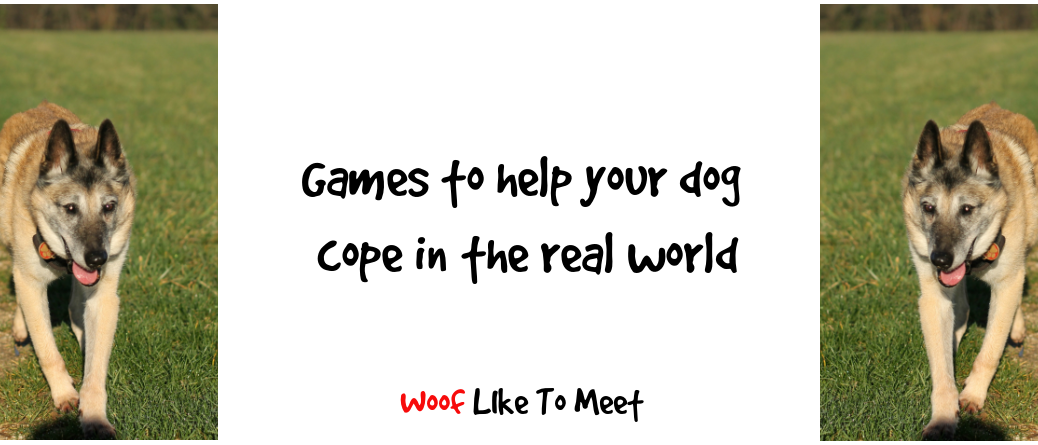
If you’ve got a dog who is reactive to everything, one of the most challenging things can be things moving up from behind, things moving alongside and things coming head on. In my experience, head on is worst, if only because it gives the dog time to decide that they don’t like whatever is coming towards them. If that’s someone walking towards you and your dog catches sight of them over 500m away, it can take them five minutes to get to you, especially if you’re battling a dog who is pulling on the lead. Now the bit that’s like high school mathematics: even if you’re moving towards them and they’re moving towards you, it could take you 3 minutes to get past each other: 3 minutes in which your dog is deciding that this is going to be terrible. Or, deciding that this is going to be wonderful target practice for a bit of “Catch the Monkey” or “Catch the Machine”. 3 minutes of you feeling anxious and passing that anxiety down the line.
I’m a fan of avoiding triggering situations whilst we’re learning to cope, but I’m also a fan of teaching dogs incrementally how to cope. If you’ve not already read about habituation, desensitisation and counterconditioning, working below threshold and using L-turns and U-turns, you might want to do a little reading beforehand. You can also polish up your desensitisation and counterconditioning. Whilst you can avoid some triggers most of your dog’s life, it does not make for a full life. The more contact that you are likely to have with triggers that set off behaviour, the more vital it is that you train your dog how to cope with them.
One thing I’ve become very conscious of on walks is that Lidy is a visual scanner, constantly on the lookout for stuff to a) chase and kill b) chase and kill and c) chase and kill. I notice a lot of my clients’ reactive dogs like this too: constantly scanning the environment. It’s as true for reactive dogs or anxious dogs as it is for chasey dogs. They walk with their head up, constantly on alert. I find it’s very apparent with anxious dogs. Some of them spend their entire walk in visual surveillance mode.
Heston has his nose to the floor, and he’s a much more refined nose: Lidy’s telling me there’s squirrels, weasels, mountain goats and camels right here, right now, and Heston is telling her to cool her jets. She can’t seem to decide if scent is 2 minutes old or 10 days old, if it belongs to something 10 miles away or in the next bush. He’s so much more discerning: he’ll only alert if it’s close and if it’s recent, though it interests him if it’s older scent. A nose down dog is a great dog to manage. There have been many times when Heston has had his nose to the ground and I’ve managed to keep it that way whilst a hare, deer or boar shot past.
Flika was a dissector of smells. She’d have to stop and give it a very thorough investigation:

That’s not to say she spent her whole walk like that. Put a cow or a car in the scene and she’d go back to visual scanning.
Heston likes to quest: that process where they’re looking for a scent but they haven’t really got it quite yet – quite often running and ‘hoovering’ up that scent until they find the freshest. Tail up, head down, trot, canter or gallop. Visual scanning is only for when scents are really strong and you need to use your eyes because the thing is SO close.

And the Problem Child, she’s a visual scanner. The sod.
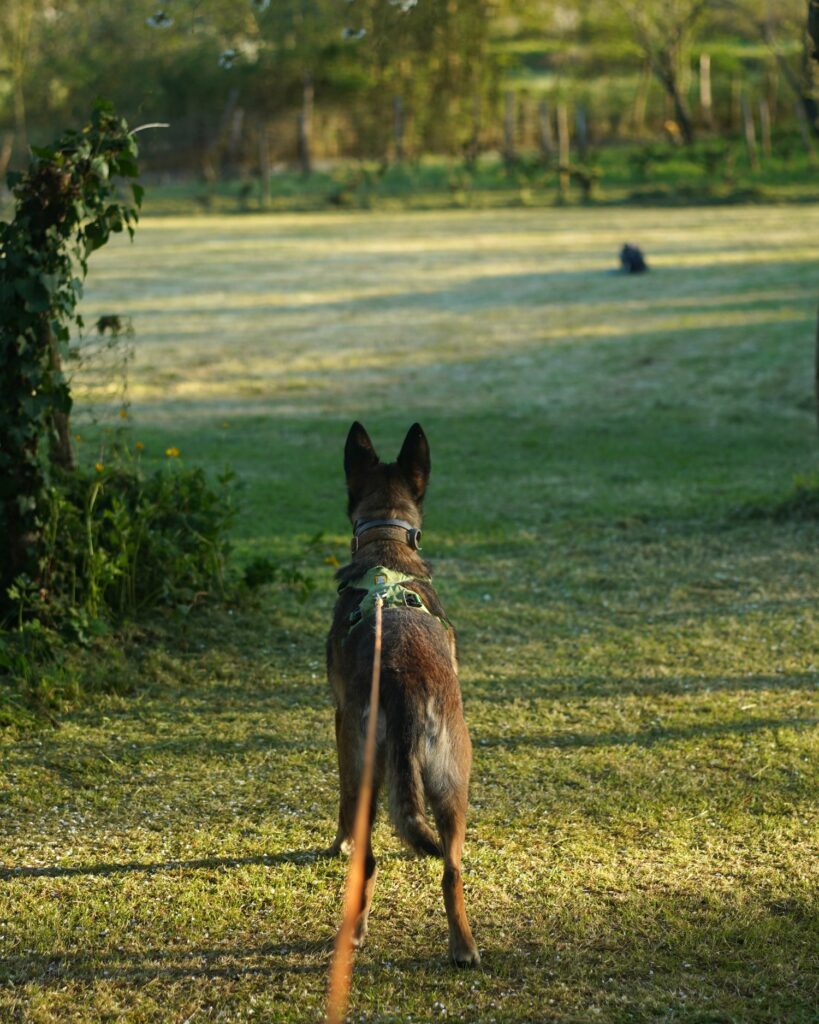
In my experience, dogs who are visual scanners are absolute sods for being really sensitive to the environment, to environmental change and for literally having more time to go over threshold. Nose down dogs, like it or not, can often be tricked. There have been many times when I’ve been able to fake out Flika or Heston simply because I saw what they were busy smelling. We’ve avoided all kinds of hare, boar, deer and dogs that way. I’m very conscious of dogs who are visually scanning the environment the whole time – they’re more likely to exhibit reactive behaviour or chasing behaviours in my experience.
You can’t fake out a visual scanner. They’ve seen it before you have. By scanning visually, they were literally waiting for things to move.
And I think visual scanning has something to do with anxious dogs’ feelings too. If you don’t feel safe enough to stick your nose to the floor and enjoy your walk, if you’re spending all your walks waiting to be pounced upon, then you’re going to find it less appealing to get your nose down and get on with being a dog.
Some dogs also need to be re-taught that it’s fine to get your nose down and sniff and investigate. So many dogs are taught to walk on a very short lead and never engage with the environment. We teach them to be visual like us, and don’t allow them to be dogs. I hate it when dogs aren’t allowed to use their primary tool of information gathering: their nose. So the activities I’m about to propose also help dogs re-engage with the world using their nose. When we forbid our dogs in gathering information in the best way they can – via their nose – we’re also limiting their understanding of the world in which we’ve placed them.
A final thing is about the appearance of dogs who are visually scanning and who have their nose down in terms of the threat level they pose to other animals, especially to other dogs. The visual scan often seems to set other reactive dogs off. Head up behaviour is instantly scary (and one reason I don’t like using fake dogs or stuffed dogs) whereas head down behaviour, whether you see it as appeasement behaviour, displacement behaviour or a calming signal, gives a very different impression. I’ve seen this so many times where I’ve encouraged my dog to stick their nose to the ground and the other dog has stopped posturing too.

A pose like this, then, can come across as quite hostile to other dogs, especially if the dog is stopped, if their mouth is closed and if they’ve got widely spread back legs.

This, on the other hand, says “not interested in you” and “just doing dog stuff.
A final reason I prefer nose down behaviours to visual scanning. It’s also why I’m not a fan of stopping still with dogs and asking them to stand. So very many reasons a ‘nose down’ is good and why it’s good to keep dogs moving.
So how do we teach our dogs ‘nose down’ behaviours? I use two techniques. The first is a game of ‘Find it!’ and the second is a Pattern Game from Leslie McDevitt called ‘1-2-3-drop!’. The first is ideal for when you’ve got something coming up from behind, if you need to move your dog quickly past or away, or if you’re moving quickly past something. The second is good when you need to be first, when you’re coming up to something, when you’re approaching a blind corner or bend.
Like everything, you need to start these easy and you need to start in a safe place. Start in the kitchen, in the garden, in the driveway.
Find it!
Start by practising at home and in the garden.
Do it so many times that as soon as you say, ‘Ready?’, your dog looks back at you and they’re ready to go hunting. Start with small throws, a metre or so, with big, smelly treats on flat ground. Graduate in complexity until you’re a pot shot over 5m or so with small treats in foliage.
If you’ve got a reactive dog, they should be on the lead in all cases until they can cope. Yes, the lead may well be playing into reactivity, but if your dog is reacting to humans, dogs, other animals or machinery, the last thing you want is them learning that aggression and charging in works. It’s the quickest way to turn reactive behaviour to aggressive behaviour.
If you’re using a longer lead than 5m, your dog has a lot of room to get into trouble. I don’t recommend longer leads until your dog can cope with everything at 5m. At the same time, if you’ve got less than a 2m lead, this isn’t really giving your dog lots of capacity to make good choices themselves. For this reason, a 2m, 3m or 5m fixed flat lead is your friend. Heston has 10m because he can cope. Lidy has 2m because she cannot. So your throwing precision needs to be as long as the lead.
‘Find it!’ is very easy. You just throw a treat in front of you about the length of the lead and tell the dog to find it! You move them forward. You can also do it moving very quickly if you’re very near the target, so if I’ve got Heston on a 10m lead, I shorten it so he has a couple of metres, throw big treats and move him forward quickly. If the target is a long way away OR they suddenly sneaked up and I need to keep my dog’s head down for longer, then a really slow ‘Find it!’ with a handful of treats into deeper foliage can also keep them busy longer. It’s a great management tool. There have been times we’ve diverted behind a bit of a screen and we’ve played a few rounds of ‘Find it!’ on the spot to keep them busy.
But you can also use ‘Find it!’ for when they see the scary or fun thing coming but have not yet reacted. They’re under threshold, still listening to you. So many people at this point ask their dog for a sit, then wait… wait… wait… maybe ask for ‘Watch me!’… and the dog is losing their patience, concentration and capacity to cope by the time the target gets closer.
I see so many problems caused by asking the dog to be static and to passively accept/cope with scary stuff or stuff they’d like to chase, especially if the target remains in their field of vision for several minutes. I needn’t tell you about the time Heston and I had to watch a whole wild boar family run across the horizon, crossing several empty fields. It must have taken them 10 minutes. How calm do you think Heston was by the end? Static behaviour like a sit or a down-stay is a tough ask when there’s moving things and you can’t chase them or run at them or run away.
‘Find it!’ keeps the dog moving forward, nose down, eyes focused on a target.
You can use it for emergency avoidance. Like I do when I spot a hare in the distance and I don’t want to cope with a very frustrated Heston.
And you can use it for counterconditioning. This is not distracting the dog, like avoiding. This is waiting for the dog to see the target, then using that as a cue to play ‘Find it!’. This process is much more conscious and is called operant counterconditioning. It’s a much less passive process, and for that I’m a big fan.
Think of it this way:
counterconditioning: scary thing appears > give dog food.
The purpose of this is to change the dog’s emotional response to the scary stuff. It doesn’t change the dog’s behaviour. It changes their feelings. You don’t need to mark behaviour in counterconditioning, because it doesn’t even matter what the dog does. Just as long as they’re accepting food, then it’s working to make them feel better about the scary stuff.
operant counterconditioning: scary thing appears > dog sees scary thing and does not react > guardian marks the behaviour with a ‘yes!’ or a ‘good!’ and then tosses the food and initiates a game of ‘Find it!’.
The purpose of this is to shape behaviour. It will also change their feelings, because ‘scary thing’ = ‘food’, just like in the counterconditioning bit. But it also reinforces non-reactive behaviour. It reinforces calmness. It shapes it from a small moment of non-reactivity into something much longer. Operant counterconditioning is the gold standard of reactive dog training.
There are lots of operant counterconditioning processes you can use.
You could reinforce check ins, where a dog sees the trigger, looks back at you and you reinforce with food. You could do this with a cue, like seeing your dog see the trigger, then asking them to ‘Watch!’ or ‘Check in!’ or you could just shape it naturally without a cue. My dogs (even the Problem Child) do this when they see a car. I don’t cue them. They look back at me and come back, sit down and we have snacks. The car cues that behaviour. That’s a gold standard because I don’t even have to pay attention to what the dog is even doing. They tell me. I can forget about the cars and they automatically come back to me and get out of the road.
You could reinforce u-turns, where the dog sees the trigger, turns back to you and you reinforce by moving in the opposite direction from the target. In a way, the car check ins are a bit like this. One dog I worked with used to see a dog and turn back, then we’d get out of the way and go and have snacks. It was much better than holding on to 40kg of air snapping, teeth clacking German shepherd trying his best to navigate bouncy labradors in the best way he knew how.
You could reinforce hand touches, where the dog sees (or senses in my case) a trigger, turns back to you and touches your hand so that you can engage with them or work with them. Lidy does this. When she’s feeling uncomfortable or a bit bitey, she touches my hand and we play games until she’s ready to cope again. Again, better than holding on to 20kg of pocket rocket maligator trying to take a chunk out of someone’s shopping bags.
Leslie McDevitt, the queen of these procedures, introduced us to “Look at that!” – and you know from my last post why I like this cued behaviour. Unlike auto check-ins or the engage/disengage game (where you reinforce disengaging behaviour), this cues the dog for a predictable turn of events. So I say, “Where’s the Dog?” and Lidy scans the environment for a dog. When she sees it, she comes back to me for food. It turns scary stimuli into a game. If I say “Where’s Fred?” it prepares her for a person. Because it’s cued behaviour (i.e. you ask for it), the dog is prepared for what they are going to see. The world becomes predictable. If you want to read up on why predictability is great for anxious dogs, then you’ll enjoy my previous post.
You can see why counterconditioning is a step up from using ‘Find it!’ to just avoid the dog seeing a trigger. It actually starts to change their feelings. And you can see why operant counterconditioning is a step up from counterconditioning, because you can shape behaviour, not just change feelings.
You’ll also see that I deliberately only mentioned scary triggers for counterconditioning and operant counterconditioning. There’s a reason for that. Safety and predictability are the key reinforcers for an anxious dog. Food is an added bonus. Safety, predictability and food are NOT reinforcing for a dog who wants to chase stuff. Walking Lidy through town near humans and she is very much in need of safety, predictability and food; she often performs hand touches to access them.
How many times did Miss Predation 2015 hand touch me today on our woodland walk?
How many times did she engage with me without cuing?
None.
A big, fat zero.
Because… chasing… chasing… stuff to maybe chase and smell and chase and bite and smell and bite and eat.
Can you use food with dogs with strong predatory behaviours? Not at first, no. Chasing is the number 1 fun. Nothing you can offer (and no punishment you can inflict) is as fun as chasing. This is why desensitisation is a better friend. Heston today recalled for a food treat when we saw a deer. That took 8 years to achieve, lovely readers. 8 years. To be fair, I’ve only really been trying for 5 of those 8. We’ve been gradually picking off things he likes to chase, one by one, and working on them. Here he is, not fussed by cows. The other week, the cows were right at the fence line and one stuck her head through. He ignored her. She was just there. She might as well have been a leaf on the bush or a crazy piece of grass. When he was 10 weeks old, he barked at cows non-stop. We did a lot of desensitisation and now frisky, frolicking cows can do their business right up by a very flimsy barbed wire fence and my dog is ‘meh!’
That is also true for horses, for sheep, for goats, for chickens (we’re revisiting cats!) and for all manner of game birds. A pheasant in the bush didn’t get a reaction yesterday. Nor a fat little partridge. Ducks, the same. We picked off each one and we worked on desensitisation. This from a dog who once chased swallows for 30 minutes in a field. Part of it is just being older and not having the same thrill. He’s much less bothered by squirrels, weasels, badgers and rabbits since they have very good evasive techniques. His big thrills were running stuff on open ground: hare, deer, boar. But we cope with them these days. Desensitisation is a part of that. But what is vital is that we meet those ‘chase’ needs. That means a bit of a dopamine hit, a bit of hunting, a bit of running, a bit of chasing. ‘Find it!’, lame as it is, is a loose approximation of this. No, it is never going to compete if your dog is sensitive to things that move – Lidy is a long way from even coping with smells and sounds, let alone seeing moving things – but when you couple it with desensitisation and you practise often, then you’ve got something that can meet a little of that need.
1-2-3-Drop!
This is one of Leslie McDevitt’s Pattern Games as well. Here, you start counting, ‘1… 2…. 3…’ and then you drop a treat on the floor. Instead of tossing it in front of you, you drop it at your feet or slightly behind. Immediately you’ve dropped it, you start walking forward and start counting again. The dog is then trying to catch up with you and you’re able to use yourself as a bit of a screen as well as keep their head down. It’s more regular than ‘Find it!’ and the treat is easier to find. I usually use something pretty visible and this is not a routine that involves them hunting or looking for the treat, just putting their head down.
Like ‘Find it!’ you can use the rhythm to go quickly or to go slowly. I find as well that I can use it to slow the dog down a little, instead of a military pace with a drop every second or so, I can drag the ‘1-2-3’ out over 6 seconds, slow paces and then speed up as we get nearer, or bring their energy down by starting quickly and then slowing down.
It is so simple, it’s insane.
I find it fairly hypnotic and Lidy clearly enjoys it when she’s feeling a bit antsy, as she’ll often hand touch and then we go into 1-2-3-drop. It puts our dogs in a positive frame of mind and gives them something predictable, something routine. The key part of desensitisation that can be really hard to achieve is working around triggers in a relaxed state. No relaxation, no desensitisation. As you can see from the Youtube video of me working through these around a cow field with Heston, his body language is relaxed, he’s loose, he’s engaged with me, he’s not fussed about the cows. Full disclosure: Heston could walk off lead past frisky bulls and not bat an eyelid, so the video is just about practising ‘Find it!’ and ‘1-2-3-drop’ as a cold trial so that when I need it, it’s as automatic as breathing.
You can, by the way, put subtitles on as I’ve added commentary about what I’m doing as we go.
Once you’ve got a really automatic recall for ‘Ready?… Find it!’ and for the ‘1’ in ‘1-2-3-drop!’ then you can start to practise in more challenging conditions.
Scenario 1
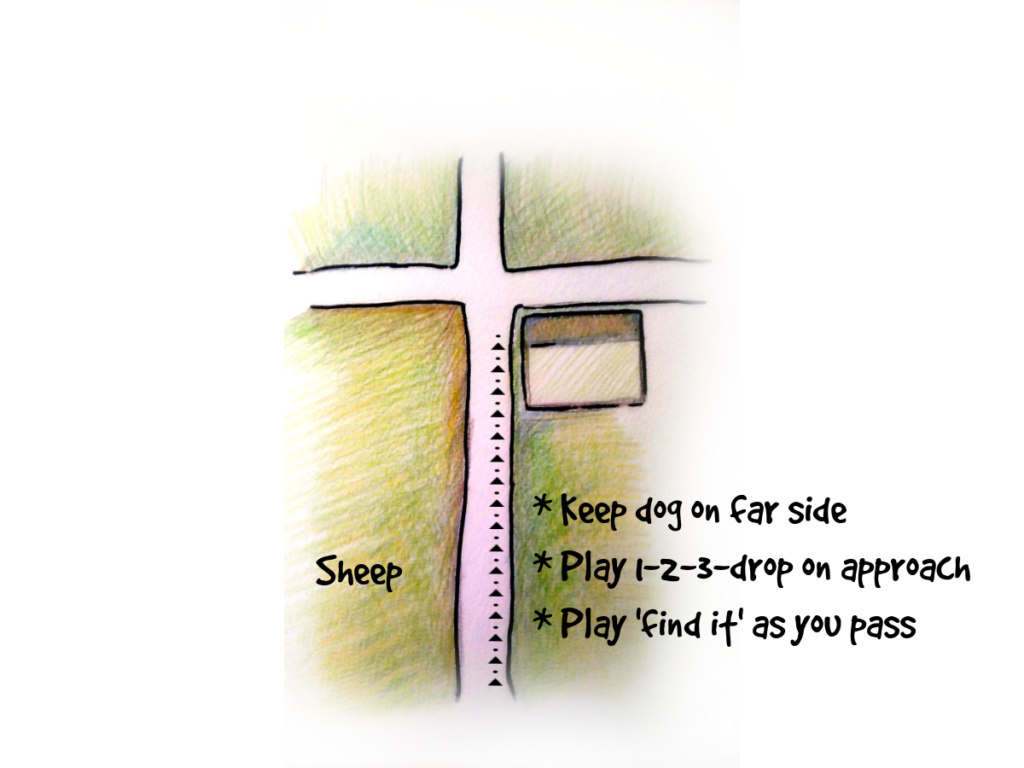
This scenario is what I call The Drive-By. In this scenario, not unlike the one I have here, using ‘1-2-3-drop’ on approach keeps your dog slightly behind and trying to catch up, so they’re focused on you as the moving target, and on a routine they have practised hundreds of times as you walk past a static or slowly moving target. Just a reminder: you don’t want these games to become a predictor of scary or interesting stuff in the environment, so make sure you always have a few cold trials at other points on the walk too. Just as you pass the last of the sheep (or horses, children in a playground, revving motorbikes or whatever it may be) switch to ‘find it!’ to high-tail it out of there. At all times, YOU are between the dog and the trigger. You are also moving at all times. It’s often in the absence of any other routine that a dog will resort to inbuilt dog stuff like chasing or reactivity, so this fills the void when your dog needs a crutch to lean on.
Scenario 2
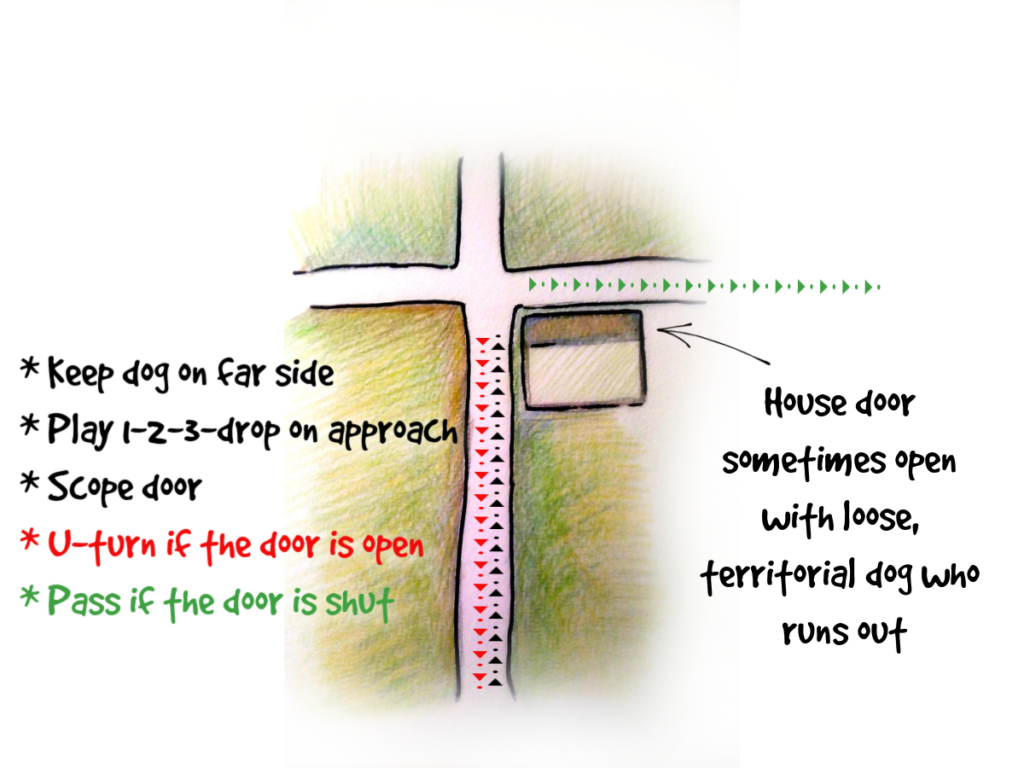
This scenario is one I call The Blind Bend. I am absolutely not a fan of reactive or chasey dogs going round blind corners first. All hell can break loose. Whilst I’m also not a fan of frog-marching dogs, or them needing to be 2 paces behind at all times, I insist on a bit of corner management.
One real-life example is just up the lane where the video was made. The house opens directly onto the street and the owners often leave the door open. Their dog usually lies in the doorway (because… dog!) and I’ve had a few hairy and narrow escapes when the door has been open and the dog has come flying out. The dog isn’t actively looking for trouble, but if the door is open, we don’t go past the front of the house. I could easily also take the left turn and move away, but the safest is a U-turn. So we play ‘1-2-3-drop’ on all blind corners, and I often encourage corner sniffing too. Corners are usually good spots for marking – cats, foxes, dogs, whatever you like… corners are often smelly. Encouraging a dog to get information by sniffing means I can get information by looking. Again, the dog should be furthest from the target or potential trouble, and ready to U-turn if necessary. We practise on literally every corner on our walk and if I have the slightest doubt, I always go round first.
Scenario 3
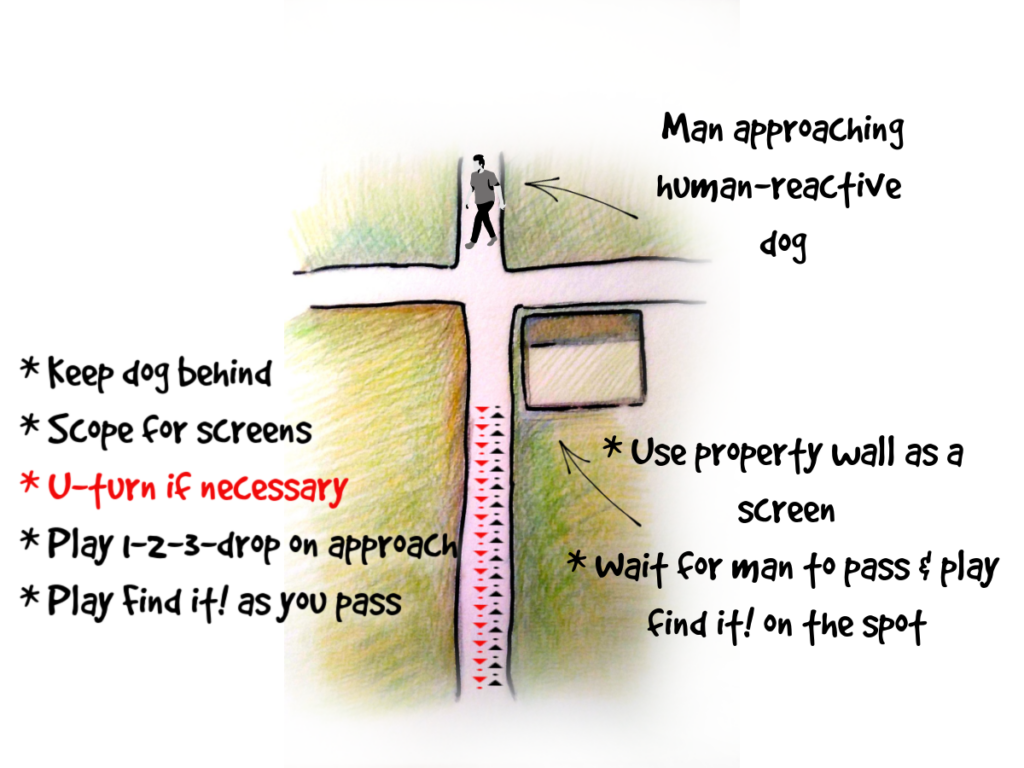
This is my High Noon scenario, where your dog is walking up to a trigger they feel is dangerous or interesting to chase. Instead of gunslinging, looking for screens, u-turning if not and l-turning if you’ve got a suitable screen, you can either play ‘Find it!’ on the spot until the trigger goes past, or you can practise some other behaviour at a distance. I might have a few games of ‘Look at That!’ if we’re safe. This is the toughest of all the scenarios, particularly if the dog has had visual confirmation of incoming threat for the last 5 minutes or so.
We can certainly feel we should try to wrestle our dog past the trigger. I don’t know what it is about human beings that we prefer High Noon to taking two minutes to step off the battlefield and wait for the enemy to walk on by.
Scenario 4
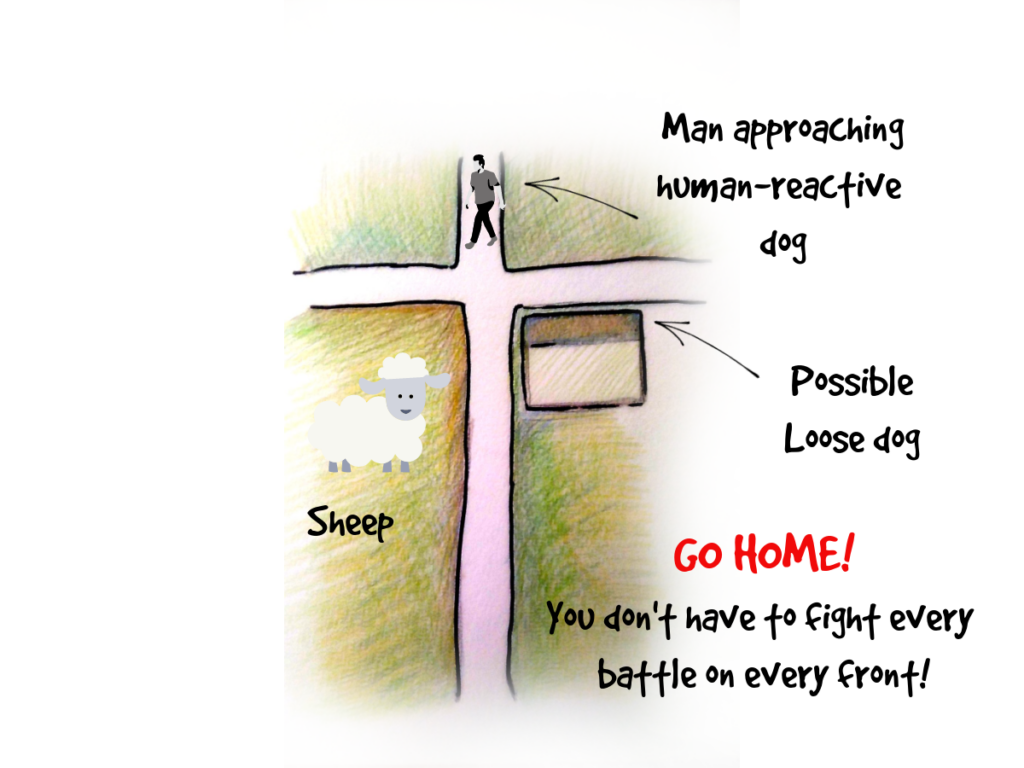
The final scenario is Misaligned Stars. For whatever reason, you’re walking into the equivalent of a trigger minefield. Sure, you could get past the sheep, dodge the oncoming trigger and cope if there’s a loose dog, but unless you feel incredibly lucky, you’ve got to ask yourself if it’s really worth it. We u-turn. We pick another walk. Simple as that. I might end up 10 minutes longer on the walk as a result, but nobody will have had a meltdown.
‘Find it!’ and ‘1-2-3-drop’ are not magic. They work through repetition in easy places until it’s an automatic response. They provide a structure for you to work at a safe distance and even provide a structure for you to work a little further into that safety bubble without incident. A busy dog will be much more able to cope with triggers all around them. If you’re interested in learning and education, there’s some interesting information about cognitive load in the classroom – basically, our problem-solving capabilities are less when we have to do more work. Giving explicit step-by-step guidance reduces the difficulty of the task and makes it much more easy the learner will accomplish it. Transferring actions to procedural memory (our muscle memory if you like) takes the pressure off. These two activities help dogs’ muscle memory take over the cognitive load, so that they can cope with managing two things at once – in this case, walking to heel and coping with scary or exciting triggers. Putting loose-leash walking to simple patterns like ‘Find it!’ and ‘1-2-3-drop’ means that this routine muscle behaviour, automatic and simple to perform, polished to perfection, means that the dog won’t struggle quite so much to cope with the complicated stuff. In theory, at least.
And if nothing else, it helps you manage the dog in relation to the position of the trigger.
As you can see from this video, nose down, moving past…
The cows aren’t at all near (about 50m) but even my one-eyed sixteen-year-old girl could have seen these (and would have reacted to them when I first adopted her, aged 14) so don’t overlook the distance you may need to work at, but don’t feel like it’s hopeless.
You may feel like you’re going to have to do this with every single trigger and it will take you a gazillion months, but in reality, once dogs realise what we’re up to, then they begin to generalise much more quickly. Sure, it took me 4 weeks to work around cows, but it didn’t take me 4 for sheep, chickens, cats, horses, goats and the other animals we come across in the neighbourhood. The aim is to make these triggers no more and no less a part of the landscape than the trees and the water butts and the bushes and the fence posts.
So if you have a reactive dog, start teaching these skills now. Start easy, start simply, start without the trigger near you at all. And then, very gradually, up your game. After all, if a one-eyed old lady can learn not to chase and not to lunge, then I’m pretty sure there’s hope for us all.
In memory of Miss Flika
30.05.04 – 28.09.20

May we all live as joyfully as you

